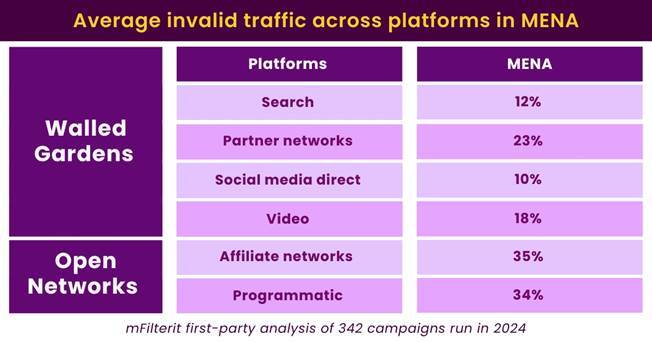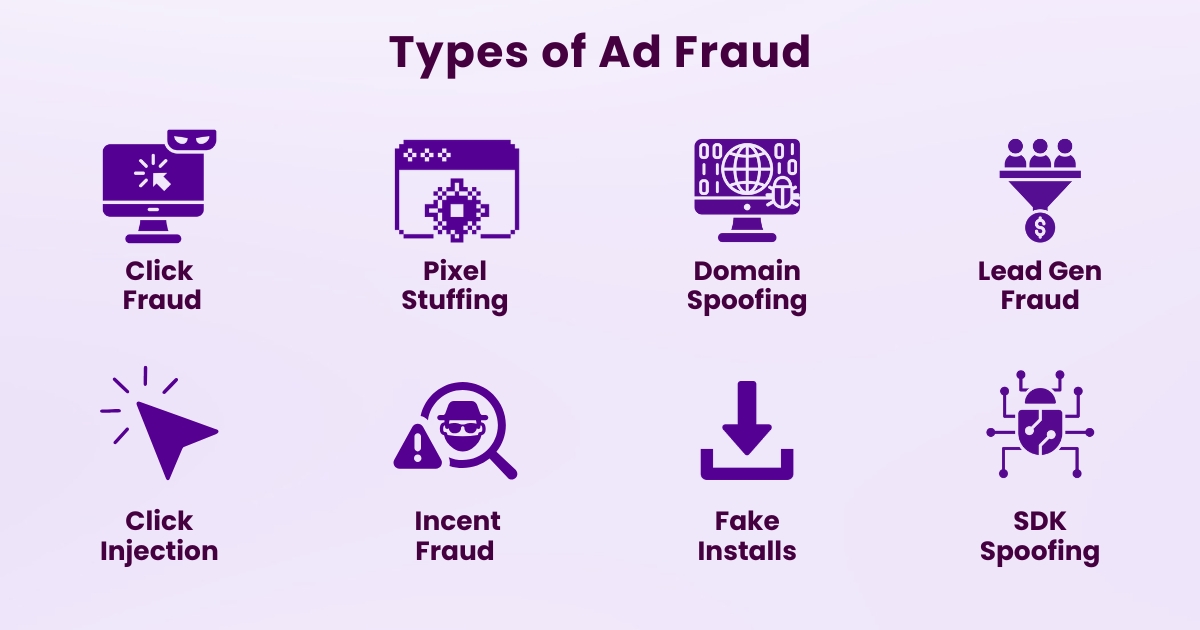In recent years, the MENA region has emerged as one of the fastest-growing digital advertising markets in the world. With ad spend projected to exceed $8 billion by 2026, the region is experiencing an unprecedented surge in number of mobile-first users, rising eCommerce platforms, and innovative app ecosystems. But along with this digital acceleration comes an equally aggressive threat: ad fraud.
According to IAB MENA, up to 20% of ad budgets in the region, roughly $1.25 billion in 2023, may have been wasted due to fraudulent activity like fake clicks, spoofed installs, bot traffic, domain spoofing, and misattributed conversions, etc. And it’s only getting worse. This budget wastage is projected to go up to $1.6 billion by 2026.
This staggering figure reveals a silent budget drain that’s not just affecting the bottom lines of brands in MENA – it’s distorting performance metrics, eroding trust, and misleading optimization decisions.
If your campaigns are optimized based on corrupted data, your ROAS is lying to you. If you’re relying on outdated, conventional ad fraud detection tools, you’re exposed to sophisticated tactics that go undetected in your app and web funnel.
Now the question that arises is – How do we tackle this effectively across the entire ecosystem?
Ad fraud in MENA is evolving rapidly, and so should your defense tech stack.
In this article, we’ll explore how ad fraud violates across web and app ecosystems in MENA, why traditional verification methods fall short, and the need for advanced ad fraud detection solutions to protect the digital ad spending of digital-first brands.
What Is Ad Fraud and Why Is MENA Especially at Risk?
The Middle East and North Africa (MENA) region faces a particularly elevated risk of ad fraud. Here’s why:

Rapid Digital Growth and Increased Ad Spend
- Booming Digital Adoption: MENA is witnessing an explosive expansion of digital connectivity and e-commerce, prompting a substantial shift in brand budgets towards online advertising to engage the large scale of digital audiences.
- Prime Target for Fraudsters: This escalating investment naturally makes the region a highly profitable target for sophisticated ad fraud techniques.
Specific Vulnerabilities in the MENA Ad Ecosystem
- Reliance on Aggregators and Smaller Networks: Many regional marketers depend on affiliate aggregators or smaller ad networks, which often lack robust transparency and rigorous vetting procedures, inadvertently increasing exposure to fraudulent activities.
- Trust-Based Partnerships: The prevalence of trust-based business relationships can sometimes bypass the need for stringent validation processes, creating openings for fraudsters to infiltrate the ecosystem.
- Localization Gaps: Generic ad fraud detection tools may not be fully optimized for MENA’s diverse languages and distinct user behaviors, allowing certain fraudulent patterns to slip through undetected.
- Lack of Benchmarks: The scarcity of widely accepted, region-specific benchmarks for campaign performance complicates the identification of anomalies and the accurate assessment of campaign effectiveness, masking the impact of fraud.
- Fragmented Technology Infrastructure: Varying levels of programmatic maturity across different MENA countries can result in inconsistent ad delivery, measurement, and fraud detection capabilities.
- Dependency on Platform-Driven Metrics: A common over-reliance on metrics provided directly by ad platforms, often without independent verification, can lead to a lack of control and transparency, making fraudulent metrics harder to discern.
Types of Web and App Ad Fraud Impacting MENA Brands
Understanding how ad fraud operates across the funnel is critical to combating it effectively. Here are the most common forms of ad fraud affecting digital campaigns in the MENA region:

Web Fraud
- Click Fraud & Click Spamming: Fraudsters use bots or scripts to simulate user clicks, inflating CPC costs and diminishing ROAS.
- Pixel Stuffing & Ad Stacking: Ads are rendered invisibly (e.g., 1×1 pixels) or layered behind other content to be counted as impressions but never seen.
- Domain Spoofing: Fraudsters mimic premium publisher domains to sell low-quality or non-existent inventory.
- Lead Gen Fraud: Fraudsters submit fake or low-quality leads to exploit CPL campaigns, draining budgets and sales resources.
App Fraud
- Click Injection: Malicious apps on user devices simulate clicks just before a legitimate install, stealing attribution credit.
- Incentivized Installs: Users are offered rewards (e.g., cashbacks or discounts) to install apps without true interest in skewing retention metrics.
- Fake Installs & SDK Spoofing: Bots mimic install behavior or exploit app SDKs to fake installs and in-app engagement.
When such fraud goes undetected, it doesn’t just waste budgets – it corrupts analytics, misleads media decisions, and diminishes LTV (lifetime value) from fraudulent users who will never convert or engage meaningfully.
How Ad Fraud Impacts Businesses in MENA
- Wasted Spend: A large portion of ad budgets go to non-human or low-value traffic sources.
- Skewed Attribution: Fraudulent actions misattribute conversions, leading brands to invest in ineffective channels or partners.
- Reduced ROAS: Since bot-driven or false installs never lead to real engagement, return on ad spend drops.
- Data Misalignment: KPIs become unreliable because of incorrect data, affecting optimization decisions and long-term planning.
- Brand Risk: Ads placed on spoofed or irrelevant domains damage brand integrity.
Fraud also masks real performance issues, giving marketers a false sense of success when in reality, the wins are artificially inflated.
Why Traditional Methods Aren’t Enough in MENA’s Digital Landscape
Despite the rising complexity of ad fraud schemes, many advertisers in the MENA region still rely on outdated or incomplete methods of verification. They don’t offer the speed, depth, or contextual intelligence modern marketers need. Here’s why traditional methods no longer provide adequate ad fraud and mobile app fraud protection:
Manual Audits and Blacklists Are Reactive, Not Scalable
- Relying on manual traffic reviews or static blacklists can only detect known and repeated patterns, missing newer, evolving fraud behaviors.
- In a high-volume, mobile-first market like MENA, fraud detection must be proactive and automated to catch dynamic threats before damage is done.
Lack of Standardization Across Ad Tech Partners
- MENA’s fragmented ad ecosystem includes multiple intermediaries and networks, many of which lack unified fraud detection protocols.
- This inconsistency creates data silos and blind spots across platforms, making it difficult for advertisers to trace where fraud is occurring or hold specific partners accountable.
Blind Spots in ROAS, LTV, and Post-Install Behavior
- Traditional tools often focus only on top-funnel metrics (clicks/impressions), ignoring critical post-install or post-click engagement.
- As a result, fraudulent users may appear legitimate in early metrics but offer zero real value, inflating ROAS while diminishing LTV.
- Without event-level data, advertisers can’t identify where and when quality drops, leading to ineffective optimization.
Outdated Technology Limits Visibility
- Many traditional fraud detection systems still use 1×1 pixel tags that can only verify surface level impressions, IP addresses, and referral URLS. It is an obsolete method in today’s multi-format, mobile-app-heavy environment.
- These outdated tags are unable to measure user engagement, monitor behavior across multiple sessions, or identify sophisticated fraud techniques such as click injection or SDK manipulation.
On the other hand, Valid8, an AI & ML based advanced ad fraud detection solution by mFilterIt uses real-time scripts, and behavioral patterns to detect fraud at every stage of the user journey.
How mFilterIt Can Help MENA Marketers Detect and Prevent Ad Fraud Across Web & App Campaigns
Here’s how Valid8 stands apart from legacy solutions and how it empowers MENA advertisers to take control of their ad spend.
Web Ad Fraud Protection with Valid8
- Post-Bid Verification – Valid8 continuously evaluates ad inventory as soon as your ads are served. This approach helps block invalid placements and ensures only high-quality impressions make it into your reporting and decision-making.
- Advanced Publisher Validation with JavaScript & VAST tags – Going beyond basic checks, our solution uses JavaScript tags and VAST tags, providing holistic coverage and deeper insights. VAST tags can evaluate traffic up to 70-80 parameters, including location, device type, session patterns, and viewability metrics etc. JavaScript tags detect how the ad is being served, visible, obstructions to it, content on the page, browser parameters, mouse parameters, screen size, etc., which is very powerful in detecting the fraud.
- Funnel-Wide Anomaly Detection – Valid8 monitors key campaign signals such as CTR, bounce rate, and conversion ratios at a granular level to detect unusual traffic behavior, including domain spoofing, bot traffic, and click spamming.
- Source- and Channel-Level Transparency – Unlike traditional solutions that offer limited visibility, Valid8 delivers channel, partner, and placement-level granularity, allowing marketers to identify trustworthy media sources, optimize spend, and non-performing partners with confidence.
App Ad Fraud Detection with Valid8
- Server-to-Server Attribution to Stop SDK Spoofing – Our solution implements S2S integration to ensure that only authenticated install events are tracked, closing loopholes that fraudsters exploit through SDK spoofing or device emulation.
- Click-to-Install Time (CTIT) Analysis – Valid8 identifies click injection and click spamming by flagging abnormal install patterns based on hyper-fast or delayed CTIT trends, offering a critical advantage in detecting fraud in performance-heavy app campaigns.
- Beyond MMPs: Enriched Post-Install Intelligence – While most MMPs stop at install validation, Valid8 goes further. It provides event-level tracking, detecting fake users, installs coming from incent fraud, or low-value actions that MMP dashboards often miss.
- Post-install & Engagement Monitoring – Valid8 correlates user activity with fraud signals such as early uninstalls or no in-app events to identify and exclude fake users that drain budget and distort LTV metrics.
- Full-Funnel Visibility for Smarter Attribution – Whether it’s a view, a click, or a purchase, our ad fraud detection tool maps the entire user journey giving you a holistic understanding of what’s genuine and what’s artificially inflated.
Conclusion: Build a Fraud-Free Future for Digital Growth in MENA
Ad fraud in MENA is more than just a performance risk; it’s a strategic barrier to digital growth. With budgets rising and fraud tactics becoming more advanced, ignoring the issue is no longer an option.
To build sustainable, performance-driven marketing in the region, brands must move beyond legacy methods and invest in advanced ad fraud detection solutions that offer full-funnel visibility, proactive actionability, and deep campaign intelligence.
For MENA advertisers looking to maximize ROAS, protect performance, and build trust in their campaign data, Valid8 is more than a detection tool – it’s a full-stack fraud intelligence solution designed for today’s high-stakes digital environment.
Ready to validate every click, view, and install before it burns your budget? Explore how mFilterIt helps MENA marketers run fraud-free, high-performance campaigns.




